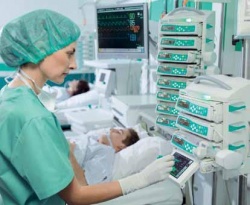Safer sleep, safer sugar
Ensuring the safety of hospitalised patients is vital – and brought under a particularly strong focus in anaesthesiology. Launched in 2010, the Helsinki Declaration provided a further boost.
Report: Holger Zorn

In many places the mastering of critical situations no longer needs to be learnt during real emergencies – it can be practised on simulators. Among the many medical and technological advances, including the latest anaesthesia workstation from Dräger, complex computing models calculate prognoses and support anaesthesia administration. EH Correspondent Holger Zorn reports on these, plus intelligent blood glucose management for non-diabetics in the ICU and other topics aired at the German Anaesthesiology Congress 2012 in Leipzig
‘Anaesthesiology means patient safety,’ says Professor Hugo van Aken, General Secretary of the German Society of Anaesthesiology and Intensive Care Medicine (DGAI), who refers to the 2010 Helsinki Declaration on Patient Safety, which was intended to establish anaesthesiology as a key medical discipline taking on categorical responsibility in this field. Much has already been achieved. Whilst the mortality rate from anaesthetics was between 1:2,500 and 1:5,000 in 1980, by the turn of the millennium it had fallen to below 8.8:100,000 thanks to the comprehensive introduction of pulse oximetry and capnography; currently the rate in developed countries stands at 1:100,000.
However, at lot still remains to be done: ‘Every fifth administration of anaesthesia does not go according to plan,’ says Dr Lars Friedrich, Consultant at the Clinic for Anaesthesiology and Intensive Care Medicine at the Hannover Medical School (MHH). Because human factors are responsible for around 70% of all incidents, he also emphasises the importance of the most intelligent assistance systems available. ‘We always need to base our assumptions on the dumbest possible user, i.e. basically anyone working in the hospital at 2.30 a.m. at night after a ten hour shift.’
Dr Friedrich, who is also lecturer and head of the Simulation Centre at the MHH, uses the new Anaesthesia Workstation Perseus A500 by Dräger as proof of his requirements: Automated functions contribute towards a reduction in the amount of work needed. With its intuitive user concept for desktop, nomenclature and touchscreen the equipment conforms to the user philosophy of the existing Dräger systems.
The VaporView, an assistance system for gas dosing, is a new addition. ‘This can lower the risk of user errors as well as the time required for user training on the equipment,’ he points out. His colleague Dr Bert Mierke, Consultant for Anaesthesiology and Intensive Care Medicine at the St. Elisabeth Hospital in Damme, confirms: ‘Especially for young colleagues it is particularly difficult in the case of low-flow anaesthesia to precisely estimate the concentration of anaesthetic gases in the breathing gases during all phases of the anaesthetic administration based on the setting of the Vapor.’
Based on pharmacokinetic models, the VaporView function on the Perseus A500 calculates the current and predicted concentration of anaesthetic gases in the breathing gasses of an adult patient. It graphically displays the actual inspiratory and expiratory concentration of anaesthetic gases over the last ten minutes and the predicted concentration for the next 20 minutes onscreen. ‘When the fresh gas flow is being reduced, after the introductory phase and consecutively the patient’s rebreathing increases, we use comparatively fewer anaesthetic gases and simultaneously establish a better breathing gas acclimatisation,’ Dr Mierke explains.
VaporView supports the anaesthetist in better calculating the concentration of anaesthetic gases in the inspiratory and expiratory breathing gases. If he changes the setting of the Vapor, the V aporView shows him the calculated, predicted concentration of anaesthetic gases in preview before this concentration actually reaches the patient. It helps him to adapt the setting of the Vapor to the respective status of an adult patient more easily. ‘This helps us to dose more safely and to avoid under-or overdosing,’ Dr Mierke confirms. This is a contribution towards increased patient safety within the meaning of the Helsinki Declaration.
Also focused on patient safety, B. Braun adds: ‘With the SpaceGlucoseControl the company has introduced a system for monitoring blood glucose levels in patients in intensive care. Increased blood glucose levels in hospital are not only found in patients with a history of diabetes. Hyperglycaemia and insulin resistance are often also found in severely ill patients. ‘Medical studies have shown that controlling blood sugar levels and the introduction of an insulin treatment protocol contribute towards a reduction in mortality and morbidity and to shorter stays in intensive care,’ says Jan Hendrik Kwiatkowski, Junior Marketing Manager for Automated Infusion Systems at B. Braun Melsungen AG.
Space GlucoseControl ensures regular control, calculates the required dose of insulin using an underlying algorithm and also takes into account the patient’s enteral and parenteral diet. Without such as system control has to be carried out manually. ‘A very time consuming method,’ Jan Kwiatkowski observes, ‘which asks a lot of responsibility from the nurses, as they mostly have to determine the insulin dosage intuitively, and also because strict glucose control always has an inherent risk of hypoglycaemia.’ Thirteen partners from seven European countries have developed this intelligent dosing algorithm – a EU project that also attracted the interest of the German Health Minister Daniel Bahr in Leipzig.
The 2010 Helsinki Declaration for Patient Safety in Anaesthesiology, prepared jointly by The European Board of Anaesthesiology (EBA) and European Society of Anaesthesiology (ESA) provides a focus for improvements in the safety of patient care in Anaesthesiology and related medical fields of perioperative care, intensive care medicine, pain therapy and emergency medicine throughout Europe. The specialty of anaesthesiology has been at the forefront of the patient safety movement for many years.
10.07.2012











